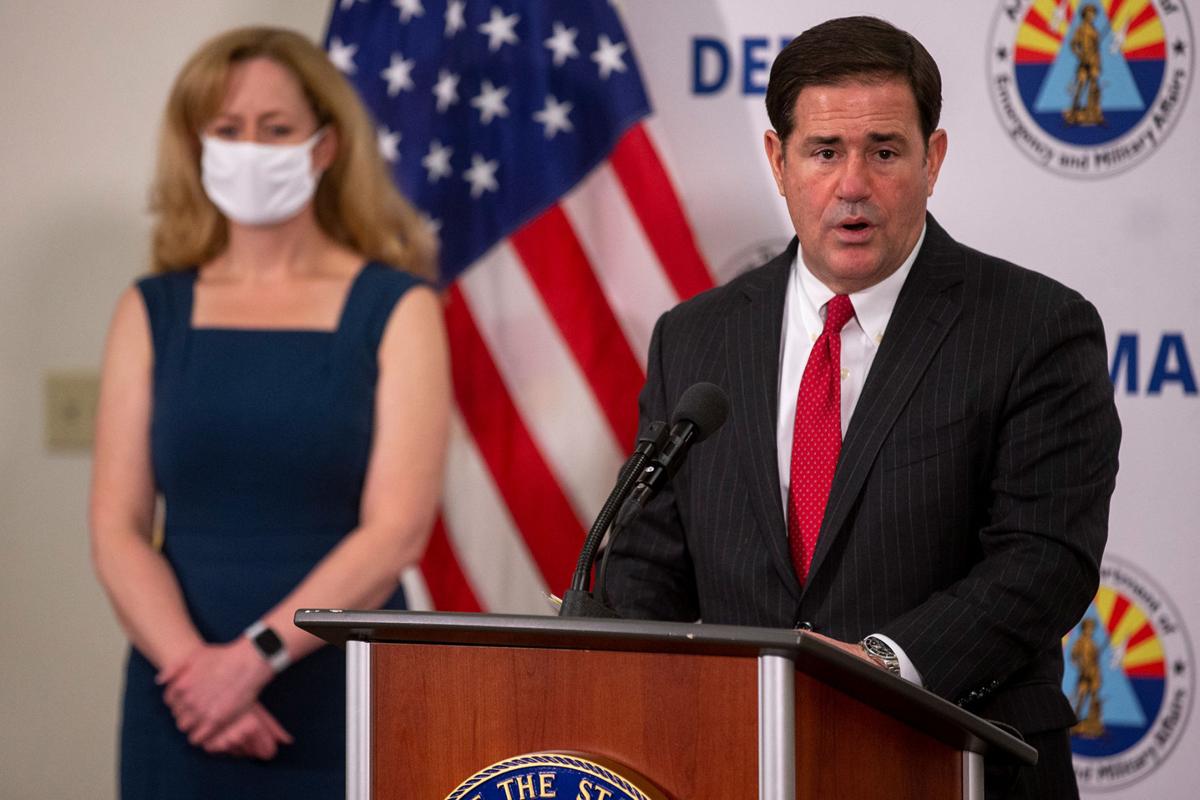PHOENIX — Gov. Doug Ducey says he won’t intercede or criticize school districts that opt to reopen for in-class instruction though their communities do not meet the COVID-19 benchmarks set by his health director.
“We want people to follow the benchmarks,” which are three key indicators of the spread of COVID-19, the governor reiterated at a press briefing Thursday.
Only two counties have reached the benchmarks: Apache and Yavapai. There is no indication when conditions in the other 13 counties will get to the place where the health department says schools can begin “hybrid” teaching, meaning a combination of virtual and in-person learning.
An August, 2020, heatwave continued into a second week in Tucson and throughout Arizona. Tucson broke a record with a high temperature of 111-degrees. Most days bounce around from 106-109, with little monsoon rain to cool the afternoons. Video by Josh Galemore / Arizona Daily Star
But Ducey said he sees these benchmarks as less clear cut.
“They are guidelines,” he said, adding that other things should also be considered, such as trends, and situations for those most directly involved.
“There are some parents that want, as soon as it’s possible, to get their children back into a classroom,” Ducey said. “And there are parents that we all know are not putting their child back in the classroom.”
He said the state is trying to “provide options” for both.
However, “We also have some teachers that are in a vulnerable category or have an underlying health condition,” Ducey said. “And we will need online learning in this hybrid model.”
Where the counties stand
All 15 counties meet the first of the three benchmarks: two weeks where hospital visits due to COVID-like illnesses fall below 10% of the total.
And 11 counties are showing a two-week decline in the total number of cases or, in the alternative, a case rate of less than 100 per 100,000 residents. Cochise, Greenee, Pima and Pinal do not.
Only Apache, Cochise, Greenlee and Yavapai counties meet the third prong of having fewer than 7% of tests for the coronavirus come back positive.
Flu will also be an issue
COVID-19 may be just one of the health problems schools face.
“Arizona’s flu season goes about October to May, with our hardest months usually being January to March,” said state Health Director Dr. Cara Christ. She promised a public relations campaign in hopes of getting as many people to take the flu vaccine.
“While it’s not 100% effective it does significantly reduce hospitalization and complications and bad outcomes,” Christ said.
Ducey hinted that he might use some federal coronavirus dollars to help provide vaccines to those who may not have health insurance. “I want to find a way that any Arizonan that wants to get a flu shot can get one,” he said. “Details to follow.”
Photos: Back-to-school in Tucson during the pandemic
"Mustang Stampede"
Updated
Maddy Jacobs, 7, middle, reaches for her remote learning tool kit from her teacher, Kris Green, as her friend, Carly Kupinski, 6, watches during a "Mustang Stampede" at Manzanita Elementary School for the first day of school on August 17, 2020.
First Day of School, John B. Wright Elementary
Updated
Augusta Iranzi, center, attends his teachers online class while monitors Jasmine Phillip, left, and Nadifo Yusuf, watch students inside a classroom at John B. Wright Elementary School, 4311 E. Linden St., in Tucson, Ariz. on August 17, 2020. About 10 students came to school for online instruction under the guidance of classroom monitors.
"Mustang Stampede"
Updated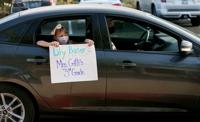
Lily Baser, 8, identifies herself for easy remote learning tool kit pickup during a "Mustang Stampede" at Manzanita Elementary School for the first day of school on August 17, 2020.
"Mustang Stampede"
Updated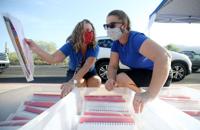
Krista Westmoreland, left, a third grade teacher, shows the remote learning tool kit of a student to Anna Ames, music teacher, during the "Mustang Stampede" at Manzanita Elementary School for the first day of school on August 17, 2020.
"Mustang Stampede"
Updated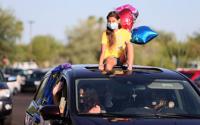
Maya Brown, 9, rides in style for her remote learning tool kit pickup during a "Mustang Stampede" at Manzanita Elementary School for the first day of school on August 17, 2020.
"Mustang Stampede"
Updated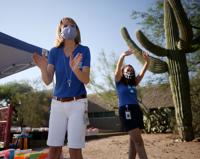
Multiage teachers Kris Green left, and April Pollow greet and cheer on their students during a "Mustang Stampede" at Manzanita Elementary School for the first day of school on August 17, 2020.
"Mustang Stampede"
Updated
Maddy Jacobs, 7, left, waves to her teacher as she stands in the sunroof with her friend, Carly Kupinski, 6, during a "Mustang Stampede" to pickup their remote learning tool kit at Manzanita Elementary School for the first day of school on August 17, 2020.
"Mustang Stampede"
Updated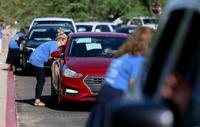
For the first day of school teachers at Manzanita Elementary School greeted their students during a "Mustang Stampede" and handed out remote learning tool kits on August 17, 2020.
"Mustang Stampede"
Updated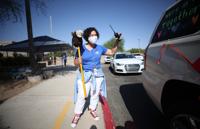
Kim Boling, principal at Manzanita Elementary School, greets her students and parents with a mustang during the "Mustang Stampede" for the first day of school on August 17, 2020.
First Day of School, John B. Wright Elementary
Updated
Yarani Martinez gives a monitor a thumbs up to inform the monitor that his online class is working after classes began at John B. Wright Elementary School, 4311 E. Linden St., in Tucson, Ariz. on August 17, 2020. About 10 students came to school for online instruction under the guidance of classroom monitors.
First Day of School, John B. Wright Elementary
Updated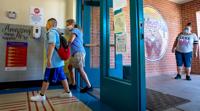
Alice Flores, right, watches as her grandson Jesus Silva is escorted to the cafeteria before classes began at John B. Wright Elementary School, 4311 E. Linden St., in Tucson, Ariz. on August 17, 2020. About 10 students came to school for online instruction under the guidance of classroom monitors.
First Day of School, John B. Wright Elementary
Updated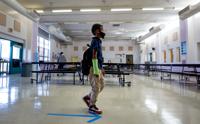
Augusta Iranzi follows the directions on the floor while being escorted to a classroom at John B. Wright Elementary School, 4311 E. Linden St., in Tucson, Ariz. on August 17, 2020. About 10 students came to school for online instruction under the guidance of classroom monitors.



